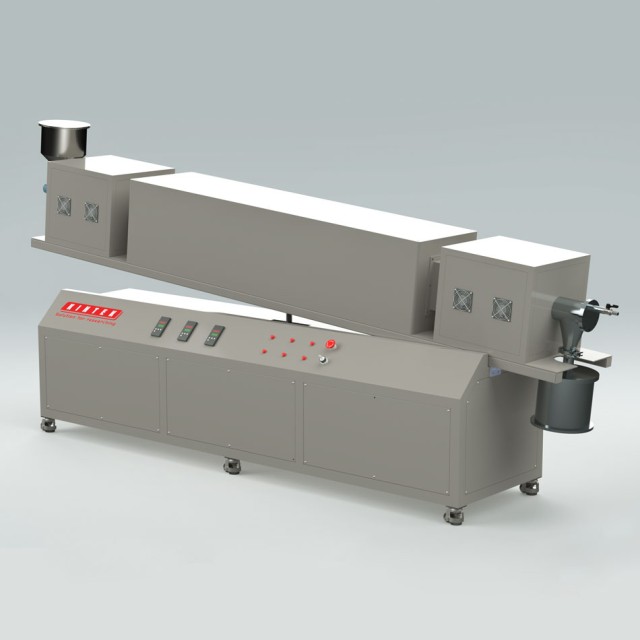
Rotary Furnace
Vacuum Sealed Continuous Working Rotary Tube Furnace Rotating Tube Furnace
Item Number : KT-CRTF
Price varies based on specs and customizations
- Max. temperature
- 1600 ℃
- Constant work temperature
- 1100℃-1500 ℃
- Heating rate
- 0-20 ℃/min
- Rotary speed
- 0-20 rpm
- Tilting angle
- -5-30 degree
- Furnace tube diameter
- 30 / 40 / 60 / 80 / 100 / 120 / 150 / 230 / 280 mm
- Single heating zone length
- 300 / 450 / 600 / 800 mm
Shipping:
Contact us to get shipping details Enjoy On-time Dispatch Guarantee.
Why Choose Us
Reliable PartnerEasy ordering process, quality products, and dedicated support for your business success.
Introduction
The inclined rotary tube furnace is used for laboratory calcination and drying of positive electrode materials, non strong acid-base powder materials, and granular materials in batteries. The furnace tube of continuous rotary furnace can be both rotating and tilting, the rotating speed is stepless speed regulated, tilting angle can be regulated as while. Vacuum tube furnace to import silicon carbide heating element, using double shell structure and intelligent program.
Detail & Parts


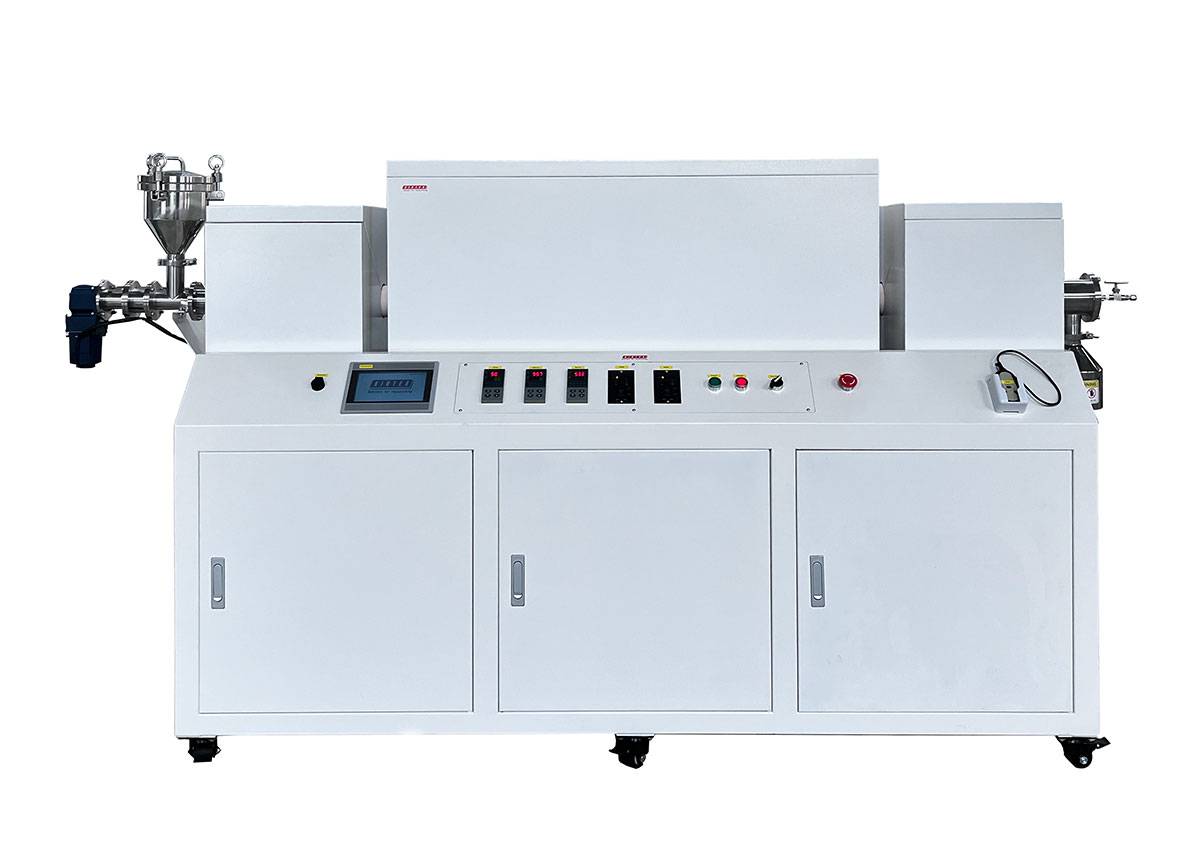
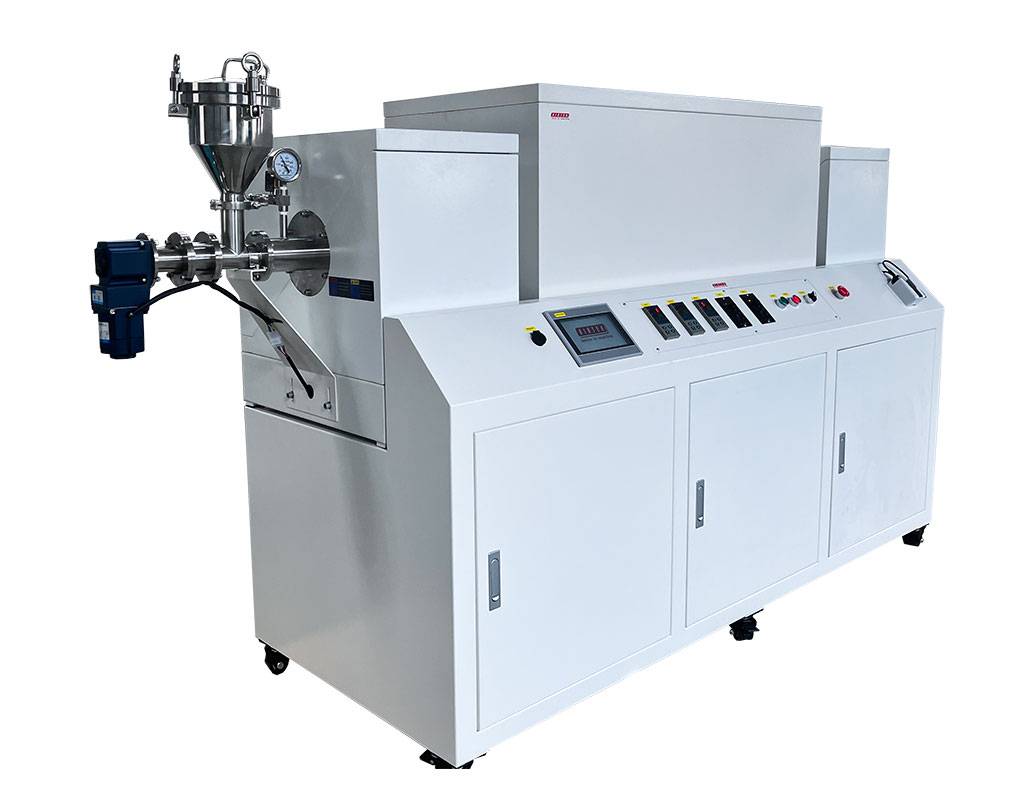

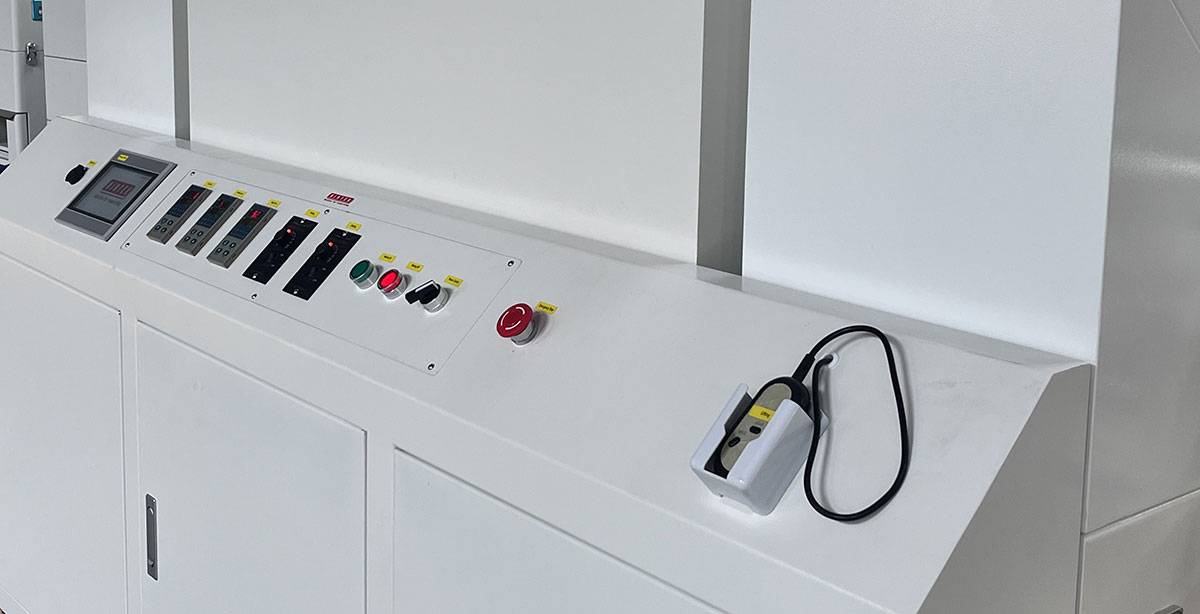
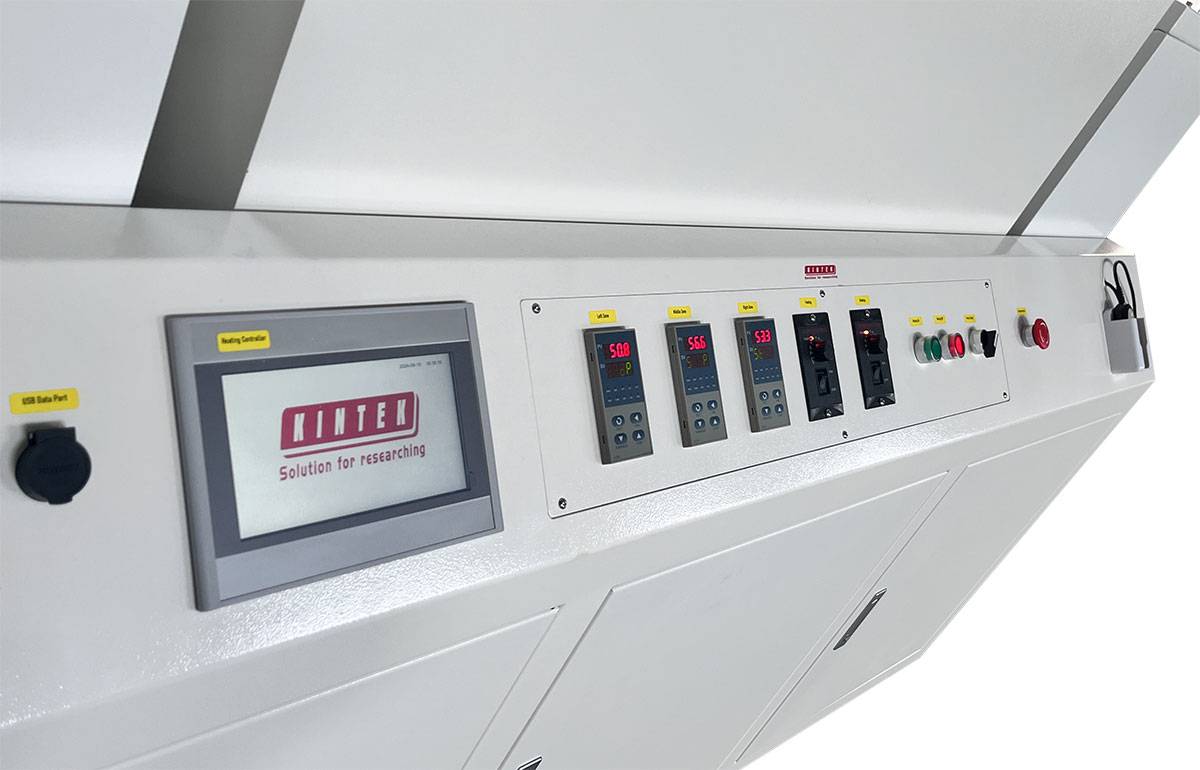
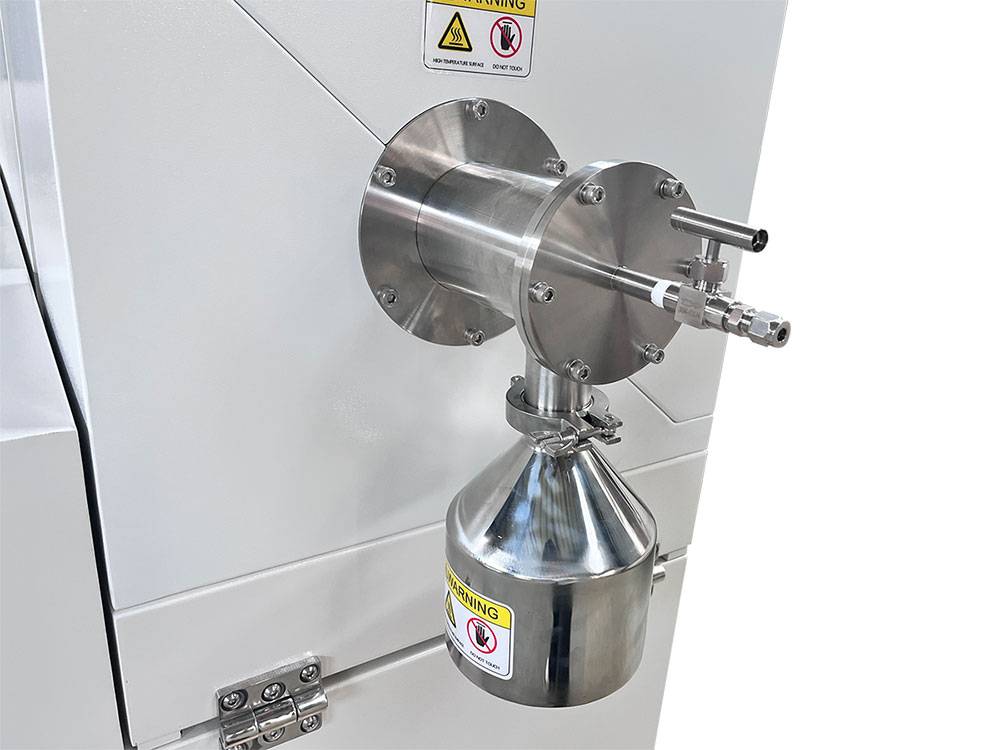
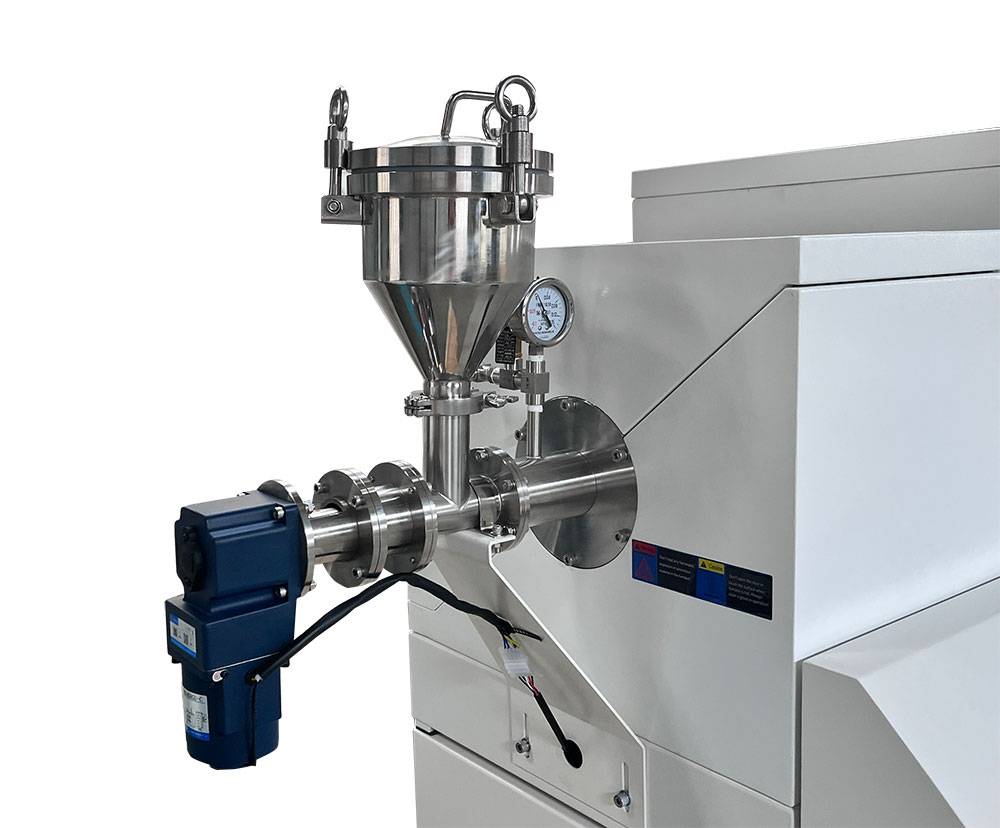
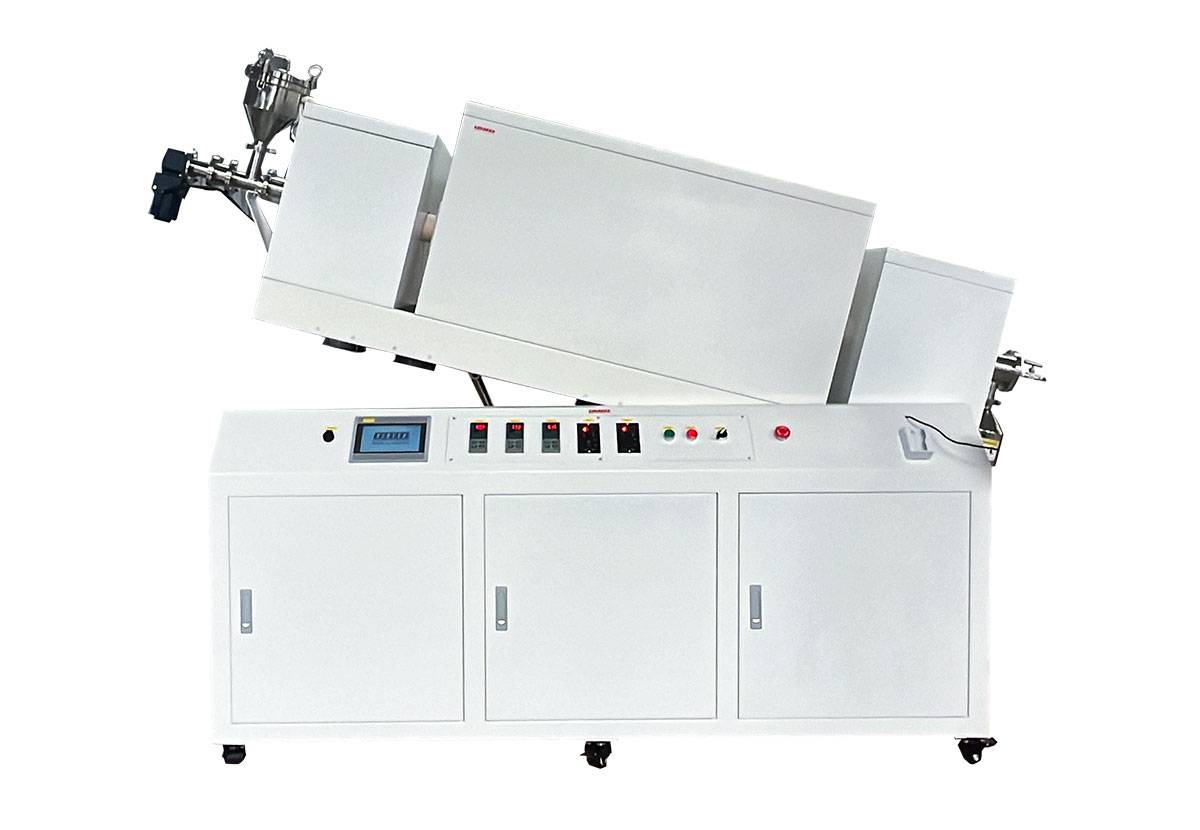
Applications
Vacuum Sealed Continuous Working Rotary Tube Furnace is commonly used in the following areas:
- Laboratory calcination and drying of positive electrode materials in batteries
- Heat treatment of non strong acid-base powder materials and granular materials in batteries
- High temperature reaction, carbonization, sintering, and pyrolysis of rare earth materials, chemical catalytic materials, magnetic materials, powder metallurgy materials, and nonferrous metal materials
- Powder or granular materials of kaolin non-metallic mineral materials
Features
The Vacuum Sealed Continuous Working Rotary Tube Furnace is a versatile and powerful piece of laboratory equipment that offers a wide range of benefits to users. Here are some of the key features of this product:
- Vacuum sealing technology: This furnace can be vacuum sealed, which allows for the processing of materials in an inert or reducing atmosphere. This is ideal for materials that are sensitive to oxidation or other reactions with the atmosphere.
- Continuous operation: This furnace can be operated continuously, which means that it can be used for large-scale production or for extended periods of time.
- High temperature accuracy: This furnace has a high temperature accuracy, which ensures that the materials being processed are heated to the desired temperature.
- Easy operation: This furnace is easy to operate, even for novice users. The 7-inch touch screen English image interface makes it simple to set up and monitor the furnace.
- Data logging: This furnace can be equipped with data logging capabilities, which allows users to track the temperature and other parameters of the process. This data can be used to optimize the process and ensure that the materials are being processed correctly.
Principle
The Vacuum Sealed Continuous Working Rotary Tube Furnace operates on the principle of continuous material movement through a work tube while maintaining a controlled atmosphere and temperature profile. The furnace tube is typically made of high-purity quartz or alumina and is heated using high-temperature heating elements, such as silicon carbide. The material to be processed is continuously fed into the furnace tube and transported through it by a rotating mechanism. This continuous movement ensures that the entire surface area of the material is exposed to the desired atmosphere and temperature, leading to uniform processing and improved product homogeneity. Vacuum sealing allows for processing under negative pressure or inert gas environments to prevent oxidation or other undesirable reactions.
Advantages
- High efficiency: The continuous rotary design allows for continuous feeding and discharging of materials, which results in a higher throughput than batch-type furnaces.
- Uniform heating: The rotating action of the furnace tube ensures that the materials are heated evenly, which results in a more consistent product quality.
- Precise temperature control: The furnace is equipped with a PID temperature controller that provides precise temperature control, which is essential for many applications.
- Vacuum or atmosphere protection: The furnace can be operated under vacuum or atmosphere protection, which allows for the processing of materials that are sensitive to oxidation or other environmental factors.
- Wide range of applications: The furnace can be used for a wide range of applications, including calcination, drying, heat treatment, carbonization, sintering, and pyrolysis.
Technical specifications
| Furnace model | KT-CRTF12 | KT-CRTF14 | KT-CRTF16 |
|---|---|---|---|
| Max. temperature | 1200℃ | 1400℃ | 1600℃ |
| Constant work temperature | 1100℃ | 1300℃ | 1500℃ |
| Heating rate | 0-20℃/min | 0-10℃/min | |
| Furnace tube material | Quartz/Metal alloys | Al2O3/Si3N4 | |
| Rotary speed | 0-20rpm | ||
| Tilting angle | -5-30 degree | ||
| Furnace tube diameter | 30 / 40 / 60 / 80 / 100 / 120 / 150 / 230 / 280 mm | ||
| Single heating zone length | 300 / 450 / 600 / 800mm | ||
| Vacuum sealing solution | SS 304 flange with O ring | ||
| Chamber material | Japan alumina fiber | ||
| Heating element | Cr2Al2Mo2 wire coil | SiC | MoSi2 |
| Temperature sensor | K type | S type | B type |
| Temperature controller | Digital PID controller/Touch screen PID controller | ||
| Temperature control accuracy | ±1℃ | ||
| Electric power supply | AC110-220V,50/60HZ | ||
| Different tube material and size and heating zone length can be customized | |||
Warnings
Operator safety is the top important issue! Please operate the equipment with cautions. Working with inflammable& explosive or toxic gases is very dangerous, operators must take all necessary precautions before starting the equipment. Working with positive pressure inside the reactors or chambers is dangerous, operator must fellow the safety procedures strictly. Extra caution must also be taken when operating with air-reactive materials, especially under vacuum. A leak can draw air into the apparatus and cause a violent reaction to occur.
Designed for You
KinTek provide deep custom made service and equipment to worldwide customers, our specialized teamwork and rich experienced engineers are capable to undertake the custom tailoring hardware and software equipment requirements, and help our customer to build up the exclusive and personalized equipment and solution!
Would you please drop your ideas to us, our engineers are ready for you now!
FAQ
What Is A Tube Furnace?
Laboratory tube furnace is one classic external heating high temperature tube furnace, also named hot wall heating furnace.
According to the different working temperature, furnace tube material usually can be transparent quartz tubes, high purity alumina ceramic tubes and high strength metal alloy tubes.
To meet different thermal researching purposes, tube furnace can be designed with multi heating zones, so as to have a flexible control of temperature gradient in the tube working chamber; furnace tube can work with a controlled atmosphere working environment or a high vacuum working environment.
What Is A Vacuum Furnace Used For?
How Does A Tube Furnace Work?
Tube furnace heating elements are placed surrounding the cylindrical cavity, furnace can only heat the samples in the cylindrical cavity through indirect thermal radiation, since furnace tube can prevent sample material from contacting with furnace heating elements and insulation materials, so tube furnace creates a clean isolated heat chamber and reduce risks of the sample material contaminating by the furnace.
What Is A Rotary Tube Furnace?
What Types Of Materials Can Be Processed In A Rotary Furnace?
What Is The Process Of A Vacuum Furnace?
What Is The Application For Tube Furnace?
Tubular furnace is mainly used in metallurgy, glass, heat treatment, lithium anode and cathode materials, new energy, abrasives and other industries, and is a professional equipment for measuring materials under certain temperature conditions.
Tube furnace features simple structure, easy operation, easy control and continuous production.
Tube furnace is also widely applied in the CVD (chemical vapor deposition) and plasma enhanced CVD systems.
How Does A Rotary Tube Furnace Work?
What Are The Rotary Furnace Types?
What Gas Is Used In A Vacuum Furnace?
How Many Different Types Tube Furnace?
Tube furnace can work with different mechanical functions smoothly, so there are many different types tube furnace variations for different experiment purposes, typical furnace furnaces are as below:
- Horizontal tube furnace
- Vertical tube furnace
- Split tube furnace
- Rotary tube furnace
- Tilting tube furnace
- Sliding tube furnace
- Fast heating and cooling tube furnace
- Continuous feeding and discharging tube furnace
What Are The Advantages Of A Rotary Tube Furnace?
What Is The Function Of Rotary Tube Furnace?
What Are The Advantages Of Rotor Furnace?
What Is The Heating Element Used In A Vacuum Furnace?
What Are The Advantages Of Using A Tube Furnace?
What Are The Advantages Of Rotary Tube Furnace?
What Is The Efficiency Of A Rotary Furnace?
What Safety Precautions Should Be Taken When Using A Tube Furnace?
Can A Rotary Furnace Be Used For Continuous Production?
How Can The Performance Of A Rotary Furnace Be Optimized?
4.8
out of
5
The vacuum-sealed rotary tube furnace is a game-changer. The continuous feeding and discharging feature is a lifesaver, and the lifting plates ensure even heating. Highly recommended!
4.9
out of
5
This rotary tube furnace has revolutionized our lab's efficiency. The dynamic vacuum sealing technology allows us to process oxidation-sensitive materials with ease. A must-have for any materials science lab.
4.7
out of
5
The build quality of this rotary tube furnace is top-notch. The furnace tube is durable, and the heating elements are long-lasting. We've been using it for months, and it's still going strong.
4.6
out of
5
The temperature control on this furnace is incredibly precise. We can achieve the exact temperature we need for our experiments, and it holds it steady throughout the process. A reliable workhorse for any lab.
4.8
out of
5
The customer service from KINTEK SOLUTION is exceptional. They were incredibly helpful in answering all my questions before I purchased the furnace, and they've continued to provide excellent support after the sale. Highly impressed!
4.9
out of
5
The vacuum-sealed rotary tube furnace from KINTEK SOLUTION is an absolute beast. It handles large processing volumes with ease, and the material comes out perfectly uniform. A game-changer for our production line.
4.7
out of
5
The energy efficiency of this rotary tube furnace is impressive. It saves us a lot of money on electricity, and it's better for the environment too. A win-win situation.
4.6
out of
5
The 7-inch TFT touch screen controller is a dream to use. It's so user-friendly, and it makes programming and monitoring the furnace a breeze. A great addition to any lab.
4.8
out of
5
The wide range of customization options for this rotary tube furnace is amazing. We were able to get a furnace that perfectly meets our specific needs. KINTEK SOLUTION went above and beyond to accommodate our requests.
4.9
out of
5
The delivery of this rotary tube furnace was lightning fast. We received it within a week of ordering, and it was packaged extremely well. KINTEK SOLUTION really knows how to take care of their customers.
4.7
out of
5
The value for money with this rotary tube furnace is unbeatable. It's incredibly affordable, but it doesn't sacrifice quality. We're getting the same performance as more expensive furnaces, at a fraction of the cost.
4.6
out of
5
The technological advancements in this rotary tube furnace are mind-blowing. The dynamic vacuum sealing technology is a game-changer, and the stepless speed regulation gives us precise control over the material movement. KINTEK SOLUTION is pushing the boundaries of what's possible.
4.8
out of
5
The rotary tube furnace from KINTEK SOLUTION has exceeded all our expectations. It's reliable, efficient, and incredibly user-friendly. We couldn't be happier with our purchase.
4.9
out of
5
The build quality of this rotary tube furnace is impeccable. It's clear that KINTEK SOLUTION uses only the finest materials and components. We're confident that this furnace will last us for many years to come.
4.7
out of
5
The customer service from KINTEK SOLUTION is outstanding. They were incredibly helpful in guiding us through the selection process, and they've been there for us every step of the way. We feel like we're in good hands.
4.6
out of
5
The versatility of this rotary tube furnace is amazing. We can use it for a wide range of applications, from calcination and drying to heat treatment and sintering. It's a valuable addition to any lab.
4.8
out of
5
The continuous working rotary tube furnace from KINTEK SOLUTION is a workhorse. It handles our demanding production schedule with ease, and it never fails to deliver. We're thrilled with our investment.
4.9
out of
5
The vacuum-sealed rotary tube furnace is a lifesaver for our research. It allows us to process sensitive materials in a controlled environment, and the results are always consistent. Highly recommended!
REQUEST A QUOTE
Our professional team will reply to you within one business day. Please feel free to contact us!
Related Products

Laboratory Vacuum Tilt Rotary Tube Furnace Rotating Tube Furnace
Discover the versatility of Laboratory Rotary Furnace: Ideal for calcination, drying, sintering, and high-temperature reactions. Adjustable rotating and tilting functions for optimal heating. Suitable for vacuum and controlled atmosphere environments. Learn more now!

Rotary Tube Furnace Split Multi Heating Zone Rotating Tube Furnace
Multi zone rotary furnace for high-precision temperature control with 2-8 independent heating zones. Ideal for lithium ion battery electrode materials and high-temperature reactions. Can work under vacuum and controlled atmosphere.

Vacuum Hot Press Furnace Heated Vacuum Press Machine Tube Furnace
Reduce forming pressure & shorten sintering time with Vacuum Tube Hot Press Furnace for high-density, fine-grain materials. Ideal for refractory metals.

Multi Heating Zones CVD Tube Furnace Machine Chemical Vapor Deposition Chamber System Equipment
KT-CTF14 Multi Heating Zones CVD Furnace - Precise Temperature Control and Gas Flow for Advanced Applications. Max temp up to 1200℃, 4 channels MFC mass flow meter, and 7" TFT touch screen controller.

Electric Rotary Kiln Continuous Working Small Rotary Furnace Heating Pyrolysis Plant
Efficiently calcine and dry bulk powder and lump fluid materials with an electric heating rotary furnace. Ideal for processing lithium ion battery materials and more.

Graphite Vacuum Furnace IGBT Experimental Graphitization Furnace
IGBT experimental graphitization furnace, a tailored solution for universities and research institutions, with high heating efficiency, user-friendliness, and precise temperature control.

Electric Rotary Kiln Pyrolysis Furnace Plant Machine Calciner Small Rotary Kiln Rotating Furnace
Electric rotary kiln - precisely controlled, it's ideal for calcination and drying of materials like lithium cobalate, rare earths, and non-ferrous metals.

Electric Rotary Kiln Small Rotary Furnace for Activated Carbon Regeneration
Revitalize your activated carbon with KinTek's Electric Regeneration Furnace. Achieve efficient and cost-effective regeneration with our highly automated rotary kiln and intelligent thermal controller.

Laboratory Quartz Tube Furnace Tubular RTP Heating Furnace
Get lightning-fast heating with our RTP Rapid Heating Tube Furnace. Designed for precise, high-speed heating and cooling with convenient sliding rail and TFT touch screen controller. Order now for ideal thermal processing!

Inclined Rotary Plasma Enhanced Chemical Vapor Deposition PECVD Equipment Tube Furnace Machine
Introducing our inclined rotary PECVD furnace for precise thin film deposition. Enjoy automatic matching source, PID programmable temperature control, and high accuracy MFC mass flowmeter control. Built-in safety features for peace of mind.

Vacuum Heat Treat Furnace with Ceramic Fiber Liner
Vacuum furnace with polycrystalline ceramic fiber insulation liner for excellent heat insulation and uniform temperature field. Choose from 1200℃ or 1700℃ max. working temperature with high vacuum performance and precise temperature control.

Vacuum Arc Induction Melting Furnace
Discover the power of Vacuum Arc Furnace for melting active & refractory metals. High-speed, remarkable degassing effect, and free of contamination. Learn more now!

Vacuum Induction Melting Spinning System Arc Melting Furnace
Develop metastable materials with ease using our Vacuum Melt Spinning System. Ideal for research and experimental work with amorphous and microcrystalline materials. Order now for effective results.

Vertical Laboratory Quartz Tube Furnace Tubular Furnace
Elevate your experiments with our Vertical Tube Furnace. Versatile design allows for operation under various environments and heat treatment applications. Order now for precise results!

Multi Zone Laboratory Quartz Tube Furnace Tubular Furnace
Experience precise, efficient thermal testing with our Multi Zone Tube Furnace. Independent heating zones and temperature sensors allow for controlled high-temperature gradient heating fields. Order now for advanced thermal analysis!

1700℃ Laboratory Quartz Tube Furnace with Alumina Tube Tubular Furnace
Looking for a high-temperature tube furnace? Check out our 1700℃ Tube Furnace with Alumina Tube. Perfect for research and industrial applications up to 1700C.

1400℃ Laboratory Quartz Tube Furnace with Alumina Tube Tubular Furnace
Looking for a tube furnace for high-temperature applications? Our 1400℃ Tube Furnace with Alumina Tube is perfect for research and industrial use.

Dental Porcelain Zirconia Sintering Ceramic Vacuum Press Furnace
Get precise dental results with Dental Vacuum Press Furnace. Automatic temperature calibration, low noise tray, and touch screen operation. Order now!

Lab-Scale Vacuum Induction Melting Furnace
Get precise alloy composition with our Vacuum Induction Melting Furnace. Ideal for aerospace, nuclear energy, and electronic industries. Order now for effective smelting and casting of metals and alloys.
Related Articles

Introducing the Lab Vacuum Tube Furnaces
A vacuum tube furnace is a type of furnace that uses vacuum to isolate the process atmosphere from the external atmosphere.

The Geometry of Heat: Why Motion Matters in Material Synthesis
Static heating creates inconsistencies. Discover how rotary tube furnaces utilize dynamic motion to achieve perfect uniformity in powder and granule processing.

Exploring Rotary Tube Furnaces: A Comprehensive Guide
Discover the workings of rotary tube furnaces, their diverse applications, and key advantages. Explore how these furnaces operate, their suitability for different processes, and factors to consider when selecting one. Find out why rotary tube furnaces are favored in advanced materials processing.

CVD furnace for the growth of carbon nanotubes
Chemical vapor deposition (CVD) furnace technology is a widely used method for growing carbon nanotubes.

The Physics of Perfection: How Rotary Furnaces Eliminate Randomness in Material Processing
Discover how dynamic heating in rotary tube furnaces overcomes the flaws of static batches, ensuring uniform, repeatable results for advanced materials.

Exploring the Functions and Advantages of Rotary Tube Furnaces
Discover how rotary tube furnaces work and why they are used in advanced materials processing. Learn about the basic technique of rotary furnaces and their customizable features. Explore the advantages of rotary tube furnaces over other furnace types.

Materials Science with the Lab Vacuum Furnace
A vacuum furnace is a specialized type of furnace that is designed to operate in a vacuum environment. This means that the furnace is sealed and the air inside is pumped out, creating a low pressure or vacuum inside.

Optimizing Industrial Processes: Rotary Kiln and Laboratory Furnace Solutions
Discover how rotary kilns and laboratory furnaces revolutionize industrial processes. Learn about rotary kiln sizing and design, laboratory furnace features, and industries served. Explore the production of carbon products like biochar and activated carbon.

guide to UNIVERSAL TUBE FURNACES
The maximum temperature in a tube furnace can vary depending on the specific model and the materials used in its construction. In general, tube furnaces are designed to operate at high temperatures, with some models capable of reaching temperatures as high as 2600°C.

Rotary Furnaces: Advanced Materials Processing and Applications
Rotary furnaces are versatile and efficient thermal processing systems used in various industries. This comprehensive guide explores the basics of rotary furnaces, their applications, advantages, and key components. Discover how rotary furnaces contribute to advanced materials processing and enhance productivity.

Advantages of Using CVD Tube Furnace for Coating
CVD coatings have several advantages over other coating methods, such as high purity, density, and uniformity, making them ideal for many applications in various industries.

Exploring the Key Characteristics of Tube Heating Furnaces
A tube heating furnace is a specialized type of industrial furnace that is used in various industries to heat substances through the use of fuel combustion.